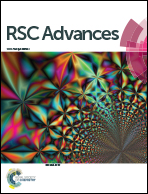Electric-field-induced structural and electronic changes and decomposition of an energetic complex: a computational study on zinc carbohydrazide perchlorate crystals
Abstract
Periodic first-principle calculations have been performed to study the effects of electric field on the geometric and electronic structures and decomposition mechanism of crystalline zinc carbohydrazide perchlorate (ZnCP). The results show that the influences of external electric field on the crystal and molecular structures are very weak and ZnCP does not undergo a phase transition at an applied field smaller than 7.492 V nm−1. Moreover, the ionic coordination bonds are more susceptible to the electric field mainly because of their weak interatomic interactions as compared to the stronger covalent bonds. In addition, the applied field across the crystal develops instabilities and ZnCP is more sensitive to the field than lead styphnate. At an electric field of 7.492 V nm−1, ZnCP has metallic properties. Interestingly, the electric field redistributes the electron density of the frontier molecular orbitals, but the decomposition mechanism of ZnCP in the presence and absence of the field is similar. Finally, the electric-field-induced decomposition of ZnCP produces many gases and the final decomposed residue is ZnO.


 Please wait while we load your content...
Please wait while we load your content...